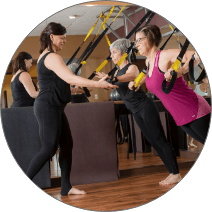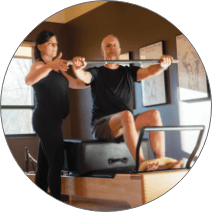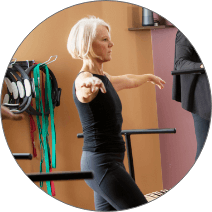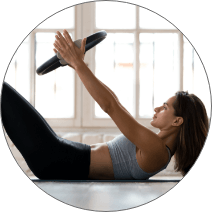Five Pilates Exercises That Will Improve Your Golf Game
Golf and Pilates are a perfect match. The functional strength and length you gain from a regular Pilates practice is the perfect combination for a golfer. Golf and Pilates share many of the same fundamentals such as breathing, centering, fluidity, concentration, and proper body alignment.
Like any sport, you must have a stable body to perform. This does not mean having the biggest, bulkiest muscles on the course. When you have a stable body, you will move better, and most of all, you’ll be pain-free. Without stability in your body, balance, and coordination are compromised, which affects your swing.
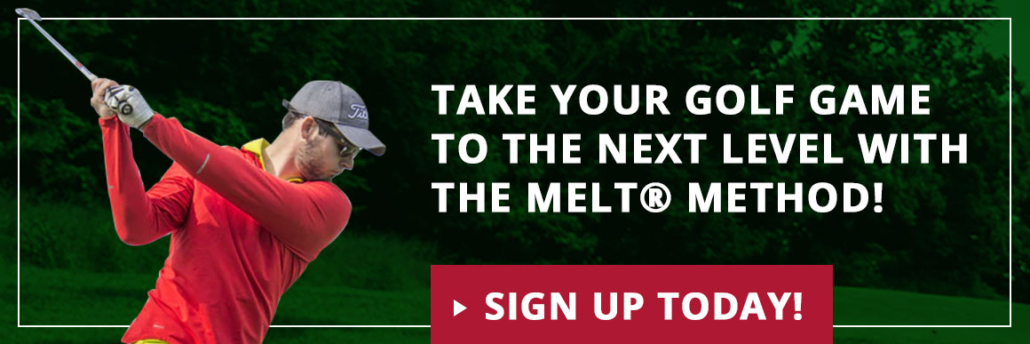
What is a stable body?
- • Coordination of balance, core strength, and muscular endurance
- • Helps maintain consistent posture
- • Core muscles, gluteals, pelvic floor, transverse abdominals, and lumbar multifidus all contribute to a strong and stable body
Like golf, the Pilates method is a practice of precision. Exercises are simple and easy to understand. The most important thing to remember when you are gaining stability in your body is to move slowly and think that you are working from the inside of your body out. It would be best if you worked from your spine for your body to be efficient in the bigger movements needed in the golf swing.
The following exercises are meant to give a foundation for the stability required for a stronger, functional body. Perform these exercises 3-4 times a week, about 10 repetitions each exercise.
Warm-up: Pelvic Tuck and Tilts:
This will help build stability in the pelvis and help loosen low back muscles.
- • Lie on your back
- • Imagine your pelvis parallel to the floor
- • Lift using glutes, rock your pelvis towards your navel, and then to the floor
Watch for:
- • Driving the movement with your gluteals — keep them relaxed
- • Feeling movement in your ribs – attempt to keep the bottom of your ribs to the floor
TIP: If you feel this in your neck, you may need a small pillow under your head.
Exercise One: Bridges
This exercise will help strengthen the gluteal muscles.
- • Lie with a neutral pelvis and feet hip-distance apart
- • Press slightly into your feet, and the pelvis will get lighter off the floor
- • Lift your pelvis off the floor
Watch for:
- • Lifting too high, it is important to not lift with your back or ribs
- • Cramping — if this happens, make your move smaller
TIP: Energize your knees towards your feet and place your hands on your ribs to make sure they stay low and not active in the lift
Exercise Two: Chest Lift
This exercise will help build abdominal strength and spinal stability.
- • Lie on your back with feet hip-distance apart
- • Pelvis in a neutral position
- • Place your hands on the base of your head
- • Pull your elbows towards the corners of your room
- • Pull your head back into your hands
- • Slowly lift your chest to the ceiling
Watch for:
- • Lifting to high — your abdominals must flatten when performing this move
- • Pull your head back into your hands to reduce neck strain
- • Moving your hips away from neutral
TIP: Keep this move slow and think there is a string in the middle of your chest pulling you up to the ceiling.
Add on:
- • Small rotations right and left moving from the lower portion of your rib cage
- • Make sure not to turn with your head and shoulders
Exercise Three: Quadruped Rotations
This exercise is a great way to introduce rotation into your spine and teach your body to move the ribs and hips independently. This exercise will also help with core stability.
- • Place your body on all fours making sure your wrists are under shoulders and knees under hips
- • Practice dropping your belly and re-engaging it without moving your spine
- • Place one hand over the backside of your neck to ensure your head will not drop too low
- • Rotate to that same side, thinking that the rib is pulling towards the ceiling
Watch for:
- • Leaning away from the side you are rotating to
- • Only moving your neck
- • Not keeping your pelvis parallel to the floor
TIP: Keep your weight evenly over the three extremities on the floor and think of moving from your last rib.
Exercise Four: Spine Twist To Saw
This exercise is a combination of two Pilates mat moves that will help with spinal flexibility and rotation.
- • Sit on the floor or a bolster, as seen in the video
- • Place your arms in front of you about shoulder-width apart
- • Rotate to one side without moving your arms
Watch for:
- • Moving your legs — this indicates an unstable pelvis
- • Moving your arms and head — remember to move from your rib cage
- • Not sitting upright — most beginners need a bolster to sit on or sit in a chair
TIP – master the spine twist before adding the saw
Add on:
- • Rotate to your right side and hold
- • Flex your spine forward
- • Reach your left arm towards your right big toe
- • Reach your right arm behind you
Exercise Five: Side Leg Lifts
This exercise will help strengthen the stabilizers of the hips
- • Lie on your side using the backside of your mat or a wall to help you make your body straight
- • Line the top part of your hip with the bottom, as shown in the video
- • Lift your leg no higher than your hip
Watch for:
- • Rocking your body back — a wall is helpful for this
- • Lifting your leg higher than your hip
- • Moving your upper body to help the lower body move
TIP: Keep your foot light and lengthen your leg before you lift it and visualize your body getting longer.


